Honda G100 Owner's manual
- Category
- Garden tools
- Type
- Owner's manual
This manual is also suitable for

Click SAVE to save this manual to your computer. Thank you for choosing Honda.

ENGINES'
OWNER'S MANUAL
GlOO
The engine exhaust from this roduct
contains chemicals known to t
R
e State
of Cahfornla to cause cancer, blrth
defects or other reproductwe harm.
I
I
K2
31260623
00x31-ZGO-6230
0
Honda
Motor
Co.,
LTd. 2000
@I
@
1200.2000.
11
1
@@
PRINTED IN JAPAN

INTRODUCTION
Thank you for purchasing a Honda engine. We want
to
help you
to
get the
best results from your new engine and
to
operate it safely. This manual
contains information on how to do that; please read it carefully before
operating the engine. If a problem should arise, or if you have any ques-
tions about your engine, consult an authorized Honda servicing dealer.
All information in this publication is based on the latest product information
available at the time of printing. Illustrations are based on the GIOOQA
model. Honda Motor Co., Ltd. reserves the right
to
make changes at any
time without notice and without incurring any obligation. No part of this
publication may be reproduced without written permission.
This manual should be considered a permanent part of the engine and
should remain with the engine if resold.
SAFETY MESSAGES
Your safety and the safety of others is very important. We have provided
important safety messages in this manual and on the engine. Please read
these messages carefully.
A safety message alerts you to potential hazards that could hurt you or
others. Each safety message is preceded by a safety alert symbol
A
and
one of three signal words: DANGER, WARNING, or CAUTION.
These signal words mean:
You CAN be KILLED or SERIOUSLY
HURT if you don’t follow instructions.
You CAN be HURT if you don’t follow
instructions.
Each message tells you what the hazard
is,
what can happen, and what
you can do to avoid or reduce injury.
2

DAMAGE PREVENTION MESSAGES
You will also see other important messages that are preceded by the word
NOTICE.
This word means:
-1
Your engine or other property can be damaged
if you don’t follow instructions.
The purpose of these messages is
to
help prevent damage
to
your engine,
other property, or the environment.
SAFETY INFORMATION
0
Understand the operation of all controls and learn how to stop the
engine quickly in case of emergency. Make sure the operator
receives adequate instruction before operating the equipment.
run the engine without adequate ventilation, and never run the
engine indoors.
0
The engine and exhaust become very hot during operation. Keep
the engine at least
1
meter
(3
feet) away from buildings and other
equipment during operation. Keep flammable materials away, and
do not place anything on the engine while it is running.
0
Your engine’s exhaust contains poisonous carbon monoxide.
Do
not
3

COMPONENT
&
CONTROL LOCATION
AIR
CHOKE LEVER
\
FUEL VALVE
FUEL FILLER CAP
SPARK PLUG
MUFFLER
OIL FILLER CAP
OIL
DRAIN
PLUG
4

BEFORE
OPERATION
CHECKS
IS YOUR ENGINE READY
TO
GO?
For your safety, and
to
maximize the service life of your equipment, it is
very important to take a few moments before you operate the engine to
check its condition. Be sure to take care
of
any problem you find, or have
your servicing dealer correct it, before you operate the engine.
Improperly maintaining this engine,
or
failure
to
correct
a
problem before operation, can cause a malfunction in
which you can be seriously hurt or killed.
Always perform a preoperation inspection before each
operation, and correct any problem.
Before beginning your preoperation checks, be sure the engine is level
and the engine switch is the
OFF
position.
Always check the following items before you start the engine:
1.
Fuel level (see page 13).
2.
Oil level (see page 14).
3. Air cleaner (see page
16).
4.
General inspection: Check for fluid leaks and loose or damaged
parts.
5.
Check the equipment powered by this engine.
Review the instructions provided with the equipment powered by
this engine for any precautions and procedures that should be
followed before engine startup.
5

OPERATION
SAFE OPERATING PRECAUTIONS
Before operating the engine for the first time, please review the
SAFETY
INFORMATION
section
on
page
3
and the
BEFORE OPERATION
CHECKS
section on page
5.
Carbon monoxide gas is toxic.
unconsciousness and even
kill
you.
Avoid any areas or actions that expose you
to
carbon
monoxide.
Review the instructions provided with the equipment powered by this
engine for any safety precautions that should be observed with engine
startup, shutdown, or operation.
STARTING THE ENGINE
FUEL VALV
1.
Turn the fuel valve
to
the
ON
position.
ON
2.
Turn the engine switch
to
the
ON
position.
6

Move the throttle lever
down
slightly.
FOR STARTING A
COLD
ENGINE:
Move the choke lever
to
CLOSE position.
FOR RESTARTING A WARM
ENGINE:
Do
not use the choke when
the engine is warm
or
the air
temperature is high.
Pull the starter grip lightly until
resistance is felt, then pull
briskly.
I
NOTICE
I
THROTTLE LEVER
CHOKE LEVER
STARTER GRIP
Do
not allow the starter grip to snap back against the engine.
Return it gently to prevent damage to the starter.
7

7.
If the choke was used
to
start the
engine, move the choke lever
to
the open position as soon as the
engine
warms
up enough to run
smoothly without use
of
the choke.
CHOKE LEVER
OPEN
SETTING ENGINE SPEED
Position the throttle lever for the desired engine speed.
Some engine applications use are
remotely-mounted throttle control rather
than the engine-mounted throttle lever
mown here.
For engine speed recommendations,
refer to the instructions provided with the
equipment powered by this engine.
THROTTLE
LEVER
8

STOPPING
THE ENGINE
To
stop
the
engine
in
an
emergency,
turn
the engine switch to the
OFF
position. Under normal conditions, use the following procedure.
1.
Move the throttle lever up fully.
Some engine applications use
remotely-mounted throttle
control rather than the engine-
mounted throttle lever snown
here.
THROTTLE LEVER
2.
Turn the engine switch
to
the
OFF
position.
3.
Turn the fuel valve
to
the
OFF
position.
GlNE SWITCH
FUEL
VALVE
y
9

SERVICING YOUR
HONDA
ENGINE
THE IMPORTANCE
OF
MAINTENANCE
Good maintenance is essential for safe, economical and trouble-free
operation. It will also help reduce pollution.
before operation, can cause a malfunction in which you
can be seriously hurt or killed.
Always follow the inspection and maintenance
To
help you properly care for your engine, the following pages include a
maintenance schedule, routine inspection procedures, and simple
maintenance procedures using basic hand
tools.
Other service tasks that
are more difficult, or require special
tools,
are best handled by profession-
als and are normally performed
by
a Honda technician or other qualified
mechanic.
The maintenance schedule applies
to
normal operating conditions.
If
you
operate your engine under severe conditions, such as sustained high-load
or high-temperature operation, or use in unusually wet or dusty conditions,
consult your servicing dealer for recommendations applicable
to
your
individual needs and use.
Maintenance, replacement, or repair
of
the emission control devices
and systems may be performed by any engine repair establishment
or
individual, using parts that are “certified” to
EPA
standards.
10

MAINTENANCE SAFETY
Some of the most important safety precautions follow. However, we cannot
warn you of every conceivable hazard that can arise in performing
maintenance. Only you can decide whether or not you should perform a
given task.
Failure
to
properly follow maintenance instructions and
precautions can cause you
to
be seriously hurt
or
killed.
Always follow the procedures and precautions in this
owner’s manual.
SAFETY PRECAUTIONS
Make sure the engine is
off
before you begin any maintenance or
repairs. This will eliminate several potential hazards:
-
Carbon monoxide poisoning from engine exhaust.
Be sure there is adequate ventilation whenever you operate
the engine.
Let the engine and exhaust system cool before touching.
Do
not run the engine unless instructed
to
do
so.
-
Burns from hot parts.
-
Injury from moving parts.
Read the instructions before you begin, and make sure you have the
To
reduce.the possibility of fire or explosion, be careful when
tools
and skills required.
working around gasoline. Use only a nonflammable solvent, not
gasoline,
to
clean parts. Keep cigarettes, sparks and flames away
from all fuel related parts.
Remember that an authorized Honda servicing dealer knows your engine
best and is fully equipped
to
maintain and repair it.
To
ensure the best quality and reliability, use only new genuine Honda
parts or their equivalents for repair and replacement.
11

MAINTENANCE SCHEDULE
REGULAR SERVICE PERIOD
(3)
\
Perform at every indicated month or
operating hour interval whichever
Before
each
\
comes first.
,
I
use
ITEM
U
Engine oil Checklevel
I
0
Chanoe
Air cleaner Check
10
Clean
Spark plug Check-readjust
I
Replace
Sediment cup Clean
SDark arrester Clean
I
Idle speed Check-adiust
I
Combustion
chamber
Clean
Valve
Clearance
Adjust
Fuel tank
8
filter Clean
Fuel line Check
Every
month months
20hrs
50
hrs
loo
hrs
h
rs
(Every
1
year
year
or
I
I
O(2)
years (Replace if necessary) (2)
14
15
16
-
17
19
20
-
-
0:
Emission related items
(1)
Service more frequently when used in dusty areas.
(2)
These items should be serviced by your servicing dealer,
unless you have the proper
tools
and are mechanically
proficient. Refer
to
Honda shop manual for service procedures.
(3)
For commercial use, log hours of operation
to
determine proper
maintenance intervals.
12

REFUELING
Use unleaded gasoline with a pump octane rating of
86
or higher. This
engine is certified
to
operate on unleaded gasoline. Unleaded gasoline
produces fewer engine and spark plug deposits and extends exhaust
system life.
flammable and explosive, and you can
be burned or seriously injured when refueling.
0
Stop engine and keep heat, sparks, and flame away.
Handle fuel
only
outdoors.
0
Wipe up spills immediately.
pii5K-j
Fuel can damage paint and some types of plastic. Be careful not to spill
fuel when
filling
your fuel tank. Damage caused by spilled fuel is
not
covered under the Distributor’s Limited Warranty.
FUE~
TANK
CAP
Never use stale or contaminated
gasoline or oillgasoline mixture.
Avoid getting dirt or water in the fuel
tank.
Adding fuel
1.
Remove the fuel tank cap.
2.
Add fuel to the shoulder of the
fuel strainer.
Do
not overfill. Wip
fuel before starting
Fuel
tank
capacity:
1.
(1.47
us
qt)

ENGINE
OIL
Recommended
Oil
Use 4-stroke motor oil that meets or
exceeds the requirements for API
check the API SERVICE label on the
oil container to be sure it includes the
-30
-'O
-lo
letters
SJ.
AMBIENT TEMPERATURE
SAE
IOW-30
is recommended for general use. Other viscosities shown in
the chart may be used when the average temperature in your area is
within the indicated range.
Oil Level Check
1.
Check the oil level with the engine stopped and level.
2.
Remove the oil filler cap/dipstick and wipe it clean.
3.
Insert the oil filler cap/dipstick into the oil filler neck as shown,
but do not screw it in, then remove it to check the oil level.
4.
If the level is low,
fill
to the top of the oil filler neck with the
recommended oil.
5.
Reinstall the oil filler cap/dipstick.
service classification
SJ.
Always
lo
2o
30
OIL FILLER CAP1
DlPSTlGK
UPPER
LIMIT
14

Oil Change
Drain the engine oil when the engine is warm. Warm oil drains quickly and
completely.
1.
2.
3.
4.
Place a suitable container next
to
the oil drain bolt area.
Wipe the oil filler area clean, then remove the oil filler cap/
dipstick.
Remove the oil drain
bolt
and
sealing washer, and allow the
oil
to
drain into a suitable
container. After draining,
install the drain bolt with the
sealing washer and tighten it
securely.
With the engine in a level
position,
fill
with the recom-
mended oil.
Do
not overfill.
Measure the oil level as shown
on page
14.
DRAIN
BOLT
Engine oil capacity:
0.45
J?
(0.48
US
qt)
Please dispose of used motor oil and the oil containers in a manner that is
compatible with the environment. We suggest you take used oil in a sealed
container
to
your local service station for reclamation.
Do
not throw it in the
trash, pour it on the ground, or down a drain.
I
NOTICE
I
Running the engine with a low oil level can cause engine damage.
5.
Reinstall the oil filler capldipstick securely.
15

AIR
CLEANER
A
dirty air cleaner will restrict air flow
to
the carburetor and cause poor
engine performance. Inspect the filter element each time the engine is
operated. You will need to clean the filter element more frequently than
usual if you operate the engine in very dusty areas.
pEiq
Operating the engine without a filter, or with damaged filter, will allow dirt
to
enter the engine, causing rapid engine wear. This type
of
damage is not
covered under the Distributor’s Limited Warranty.
Inspection
1.
Remove the wing nut, then remove the air cleaner cover. Be
careful
to
prevent dirt and debris from falling into the air cleaner
base.
2.
Remove the foam filter element from the air cleaner base.
3.
Inspect the filter element. Replace a damaged filter. Clean or
replace a dirty filter.
ELEMENT
CLEANING
1.
Clean the air filter with warm
soapy water, rinse, and allow
to
dry thoroughly.
Or clean in nonflammable
solvent and allow
to
dry.
2.
Dip the filter in clean engine oil,
WING NUT
then squeeze out all excess oil.
The engine will smoke when
started if
too
much oil is left in
the foam.
Be careful
to
prevent dirt from entering the carburetor.
AIR CLEANER
COVER
3.
Wipe dirt from the air cleaner body and cover, using a moist rag.
16

SPARK
PLUG
Recommended
Spark
Plug:
NGK
BPMR4A
The recommended spark plug is the correct heat range for normal engine
operating temperatures.
[
NOTICE
I
Incorrect spark plug can cause engine damage.
For good performance, the
spark plug must be properly
gapped and free of deposits.
1.
Disconnect the cap from
SPARK
the spark plug, and remove
any dirt from the spark plug
area.
2.
Use the proper size spark
plug wrench
to
remove the
spark plug.
3.
Inspect the spark plug. Replace it if
damaged, badly fouled, if the sealing
SPARK PLUG CAP
washer is in poor condition, or if the
electrode is worn. If the spark plug is
0.6
-
0.7
rnrn
to
be reused, clean it with a wire
(0.024
-
0.028
in)
brush.
4.
Measure the electrode gap with a
suitable gauge. The correct gap
is
0.6
-
0.7
mm
(0.024
-
0.028
in). If
adjustment is needed, correct the
gap by carefully bending the side
electrode.
17

Install the spark plug carefully, by hand,
to
avoid cross-threading.
After the spark plug is seated, tighten with the proper size spark
plug wrench
to
compress the washer.
When installing a new spark plug, tighten
1/2
turn after the spark
plug seats to compress the washer.
When reinstalling the original spark plug, tighten
118
-
114
turn after
the spark plug seats
to
compress the washer.
I
NOTICE
I
A
loose spark plug can become very hot and can damage the engine.
Overtightening the spark plug can damage the threads in the cylinder
head.
9.
Attach the spark plug cap
to
the spark plug.

SEDIMENT
CUP
CLEANING
1.
Move the fuel valve
to
the
OFF
position, then remove the fuel
sediment cup and O-ring.
Gasoline is highly flammable and explosive, and you can
be burned or seriously injured when handling fuel.
Stop engine and keep heat, sparks, and flame away.
Handle fuel only outdoors.
Wipe up spills immediately.
2.
Wash the sediment cup and O-ring in nonflammable solvent,
3.
Place the O-ring in the fuel valve, and install the sediment cup.
4.
Move the fuel valve
to
the
ON
position, and check for leaks.
and dry them thoroughly.
Tighten the sediment cup securely.
Replace the O-ring it there is any leakage.
FUEL VALVE
O-RING
SEDIMENT CUP
SPARK ARRESTER (optional equipment)
In some areas, it is illegal
to
operate an engine without a USDA (United
States Department
of
Agriculture)-qualified spark arrester. Check local
laws and regulations. A USDA-qualified spark arrester is available from an
authorized Honda servicing dealer.
19
Page is loading ...
Page is loading ...
Page is loading ...
Page is loading ...
Page is loading ...
Page is loading ...
Page is loading ...
Page is loading ...
Page is loading ...
Page is loading ...
Page is loading ...
Page is loading ...
Page is loading ...
-
 1
1
-
 2
2
-
 3
3
-
 4
4
-
 5
5
-
 6
6
-
 7
7
-
 8
8
-
 9
9
-
 10
10
-
 11
11
-
 12
12
-
 13
13
-
 14
14
-
 15
15
-
 16
16
-
 17
17
-
 18
18
-
 19
19
-
 20
20
-
 21
21
-
 22
22
-
 23
23
-
 24
24
-
 25
25
-
 26
26
-
 27
27
-
 28
28
-
 29
29
-
 30
30
-
 31
31
-
 32
32
-
 33
33
Honda G100 Owner's manual
- Category
- Garden tools
- Type
- Owner's manual
- This manual is also suitable for
Ask a question and I''ll find the answer in the document
Finding information in a document is now easier with AI
Related papers
Other documents
-
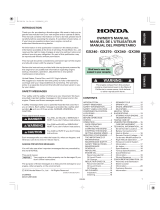 Honda Engines GX390RT2VWE Owner's manual
Honda Engines GX390RT2VWE Owner's manual
-
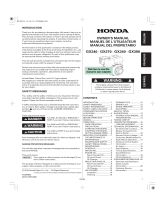 Honda Engines GX390UT2XQA2 Owner's manual
Honda Engines GX390UT2XQA2 Owner's manual
-
Emax HGES0817WL User manual
-
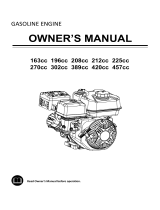 Agrico PEPE1155 User manual
Agrico PEPE1155 User manual
-
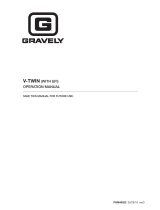 Gravely V-TWIN Operating instructions
Gravely V-TWIN Operating instructions
-
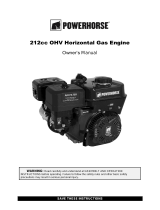 Powerhorse Single-Direction Plate Compactor Owner's manual
Powerhorse Single-Direction Plate Compactor Owner's manual
-
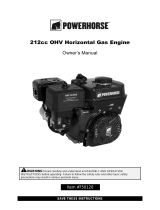 Powerhorse OHV Horizontal Engine Owner's manual
Powerhorse OHV Horizontal Engine Owner's manual
-
Powerhorse 750122 Owner's manual
-
Troy-Bilt 21A675B766 Owner's manual
-
Craftsman 919670041 Owner's manual






































